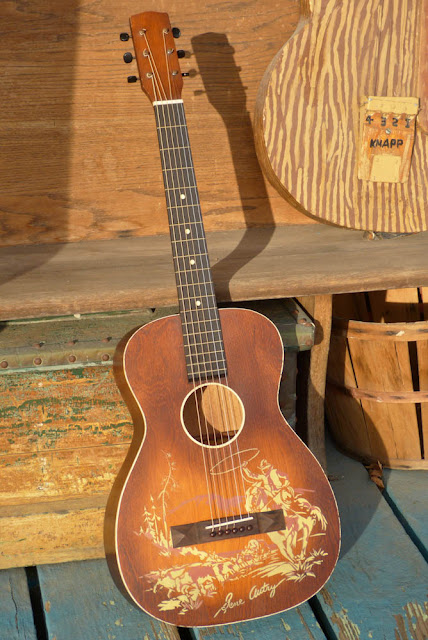1940s Harmony "Gene Autry" Cowboy Parlor Guitar
This is a customer's guitar that's been awaiting final service for a good, long time now. While the stencil is the same as used on the original 1930s "Round-Up" Harmony Gene Autry guitars and slightly-later "Melody Ranch" models, the guitar's build is clearly late-40s, early-50s, all birch, and lacks any descriptive stencil at the headstock that the earlier models would've had. Harmony often stamped a date on these but the date stamp is missing on this one.
When it came in it had the usual problems with this type of Harmony: a bellied top, split original bridge, and a desperate need for a neck reset. It got a neck set, new (compensated) bridge, new bone nut and saddle, some brace reglues, a seam repair here or there, and a set of rosewood pins to give it a more vintage look than the black plastic ones it came with. It plays spot-on (1/16" treble, 3/32" bass at the 12th fret), though the hefty neck means it's most at home in the 1-7 fret area for "cowboy" chording.
When it came in it had the usual problems with this type of Harmony: a bellied top, split original bridge, and a desperate need for a neck reset. It got a neck set, new (compensated) bridge, new bone nut and saddle, some brace reglues, a seam repair here or there, and a set of rosewood pins to give it a more vintage look than the black plastic ones it came with. It plays spot-on (1/16" treble, 3/32" bass at the 12th fret), though the hefty neck means it's most at home in the 1-7 fret area for "cowboy" chording.
The Gene Autry Harmony models got plainer and plainer as they went along. The original version was solid spruce and solid mahogany but this latter-day variant is solid birch throughout with a poplar neck, faux (painted-on) "binding," and dyed-maple fretboard.
I replace the original wood nuts on these every time because my experience is that they just wear out after a few years' use.
The brass frets were in pretty good shape, though, and only needed a light fret level/dress to get them going.
I used a vintage-looking rosewood "pyramid" bridge that's a fair-bit larger than the original. The reason here is that I had to install it on a compromised/bellied top and wanted as much safety and security as possible. I bought a whole bunch of these from a Chinese seller last year and while they're obviously "straight from the CNC," and had little in the way of fine polish as-is, they actually look more the part than your average Martin-ish repro bridge ecause of that.
Good tall saddle on that'n...
Amazingly, the guitar has only one smallish top crack that I filled and sealed -- the rest of the instrument has no signs of the usual cracking I expect to see on these.















Comments
Can i get this wonderful artwork??